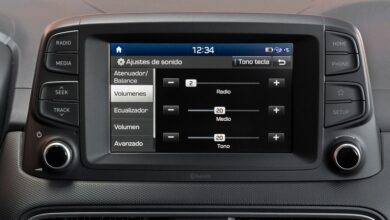Everything you need to know about the DSG change

When it comes to gear changes, it is usual for our vehicle to have a manual one, at least in Spain. But the arrival of the DSG gearbox has been offering an interesting alternative for some time, in a format halfway between the manual and the automatic gearbox.
One of the things that most surprises Americans when they arrive in Spain is that the cars have a lever to change the gears, which they have to use continuously. More or less the same thing that happens to Spaniards who arrive in the United States and can’t find the gearbox or the clutch. And it is that cars with automatic transmission in Spain are a rarity.
However, in this approach there is an interesting alternative, such as the DSG change. This technology, originally created by the Volkswagen group, incorporates the best of both worlds, uniting the high efficiency of an automatic gearbox with the sensations and control offered by a manual gearbox.
If you don’t know what the DSG is, or how this technology works, we will give you all the answers below, including some advice regarding the good maintenance of the DSG gearbox and the problems that may arise if we do not comply with it.
What is the DSG change
The first thing we have to know is what we are talking about. The DSG system was introduced in 2003 by Volkswagen, which included it in the Golf R32. This sports vehicle had 241 horses and six cylinders. This system was a new way to squeeze that power, with an improved change.
The DSG system has a mixed approach , in which the efficient control of the manual gearbox is combined with the ease of use and the speed of the automatic gearbox. In fact, if you don’t know what DSG is, these acronyms correspond to Direct Shift Gearbox , or direct activation gearbox, which gives us some clues as to where the shots are going.
The idea of the DSG gearbox is to offer a double-gear system, whereby the gearbox already has the next movement to make, depending on the driving conditions. To do this, the device has a double clutch system, which is responsible for keeping the next two gears half engaged. If we accelerate enough, then the gear is raised and if we brake, the lower gear is applied.
These two clutches are integrated into a split case system, so that one clutch moves along with the odd gears and the other clutch handles the even gears. For this reason, it is possible to change the gears in the way that we are commenting, in the way that a vehicle with two automatic gearboxes would do, so to speak.
By the way, those first boxes were a novelty but also a headache for users. The main reason was its durability, which was not always up to what would be expected in a high-end vehicle. Fortunately, that has changed over time.

How the DSG shift works
When driving, the behavior of a DSG change is similar to that of an automatic gear change. In fact, you don’t have to learn anything special to know how to use a DSG transmission if you already drive with an automatic. The box of these vehicles has a position for parking, another for reverse gear, neutral and the two driving speeds, the one with higher power and lower speed and the one with lower power and higher speed, depending on whether you walk through mountainous terrain or in plain.
Once the driving mode that suits us has been chosen, all we have to do is roll normally, although without having to press the clutch and without touching the gear lever. The central unit of the DSG is in charge of doing the complete changes for you, depending on the pace you set the car. The best of all is that, except when driving slowly, you will not notice jerks nor will you perceive gear changes. These are done at high speed but smoothly. Something that translates into a sportier feeling and better use of the engine, as we will see below.
Advantages and disadvantages of the DSG system
As with many technologies, the DSG system has many advantages, but also some drawbacks. Among those advantages, we have an ultra-fast shifting system , which is made possible by that dual DSG clutch.
Current technology allows changes to be executed in just 40 milliseconds, thus reducing the time compared to the first boxes equipped with this system. A speed that has the advantage of squeezing more power from the engine. Since the time to change gear is very short, there are hardly any power losses during these changes.
Something similar happens with consumption, which is somewhat lower in vehicles with DSG. This has to do with that same use, which does not waste energy in the changes. As a final extra, the DSG system adapts better to road conditions. Therefore, in more mountainous or complex terrain, you will always ride with the optimal gear.
Regarding the disadvantages, the most common are related to system breakdowns . A DSG change with inadequate maintenance is a guarantee that things will fail in no time. This system requires an oil change every 60,000 kilometers, derived from the high lubrication requirement of its operation.
On the other hand, there are also certain problems with the 6-speed DSG when driving at low speeds or when parking. In these cases, when releasing the brake, a movement of the car similar to the jump it makes when we put a gear in and suddenly release the clutch is perceived. Something that is not entirely pleasant.

What cars use the DSG change
Although we have talked about Volkswagen vehicles as the main reference regarding those that mount these DSG boxes, the truth is that there are several VAG group vehicles that also mount them. Among them, we have the Audi, where the system is called S Tronic. In practice it is the same, but with a name that sells more.
Regarding the rest of the manufacturers, more and more are joining this technology, similar approaches and different names. Among them, we have the Powershift system of certain Ford models, the EDC change of Renault or the TCT technology of the Alfa Romeo. Proof that Volkswagen’s idea is interesting and that it is gaining ground among manufacturers.



